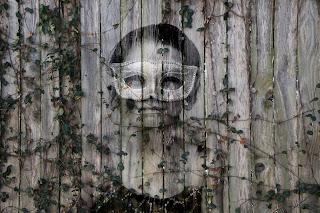I found some lovely yarn, a Cascade metallic, that I wanted to be the highlight of a pair of wrist warmers so I came up with a very basic, Plain Jane, pattern so that the yarn would be the focus. It's a great pattern! Turns out that I like the Plain Jane wrist warmers pattern with any yarn.
Can be used for the foundation of many more options as well. The pair to the left is made with the Plain Jane pattern but with a cable worked every 4 rows on the back and thus the thumb gusset moved over to the left side of the palm for the second one made.
The tan pair to the right is made with Colorscape yarn. It's a little thicker than the standard worsted weight I usually use. It's not bulky but it's thicker than worsted. I get confused sometimes when trying to figure out yarn sizes. Sock yarn and fingerling weights are easy enough to figure out. Bulky and super bulky are easy enough to figure out. Then you get in that mid-weight yarn and it can vary quite a bit even with the same designation on the label.
The instructions are for the heavier weight worsted but can be used for any medium weight yarn. For some lighter yarns I worked 12 rows between the seed edge rows and starting the gusset instead of 10 rows in order to reach my knuckles.
Since they are the same all the way around there isn't really a left hand and right hand for this pattern. Both hands can be made the same. Once you start adding patterns or cables to the back of the wrist warmers you will need to work the thumb gusset on the other side of the palm for the left hand but for this pattern it doesn't matter. It's Plain Jane. Easy Peasy.
Plain Jane Wrist Warmers
Worsted weight yarn (you can get two pairs from one skein of Colorscape)
Size 6 needles. I used magic loop but you can use DPNs or the two circular needle floppy method.
Gage: in stockinette, 4 st/inch
CO 32, join.
Rounds 1-3: seed stitch
Rounds 4-13: knit
On 13th row place a stitch marker after first 2 sts in round and after the next 3 sts. This is for the thumb gusset.
Round 14: K2, M, K1, M1R, K1, M1L, M knit rest
Round 15: knit
Round 16: K2, M, K1, M1R, K3, M1L, M knit rest
Round 17: knit
Continue increasing every other round after first st inside markers and before last stitch between markers until you have 13 sts between the markers.
After reaching 13 sts between the markers knit the second row of all knits then move the 13 sts between the markers to a holder. If you don't have a stitch holder just use a darning needle to move stitches onto scrap yarn. CO 3 using the backwards e method (need to replace the 3 sts we lost to the thumb gusset) then knit the rest of the round.
Knit 5 rounds.
Work 5 rounds of seed stitch. Bind off in pattern.
Thumb gusset: Move the 13 sts back to knitting needles and pick up 4 st to close up the opening.
Knit 3 rows. Work 3 rows of seed st. Bind off in pattern.
Weave in tails and your first Plane Jane wrist warmer is done!
Now just make the second one and you are ready for these crisp fall days or brisk spring days.
I used the alternating long-tail cast on because it matches ribbing or seed stitch start well.
Making one leaning right, grab the strand between two stitches from the front with the left knitting needle and knit through the back loop.
Making one leaning left, grab the strand between two stitches from behind with the left knitting needle and knit.
K= knit
P= purl
M= marker
M1R= make one, leaning right
M1L= make one, leaning left
Bind off in pattern= for seed stitch bind off, purl into knit then knit into purl, pass stitch over, continue
Seed stitch= K1, P1 across, next row purl into knits and knit into purls, continue working each row by working a purl or knit into opposite.
Getting ready to start gusset by placing stitch markers around 3 sts. I work the 2 sts at the start of the row outside the thumb gusset because I don't want to work the thumb gusset right on the edge.
Here's the completed thumb gusset with 13 sts between the stitch markers. Getting ready to move those 13 sts to a stitch holder and wrap up the wrist warmers. Only 5 rows of knitting and then 5 rows of seed stitch and we are in the homestretch.








